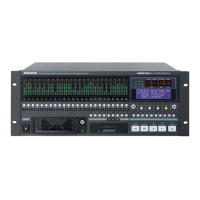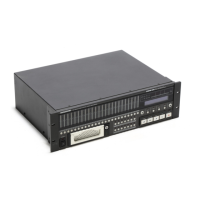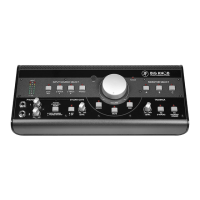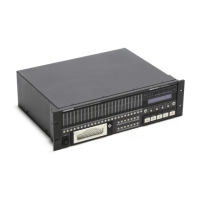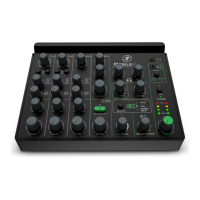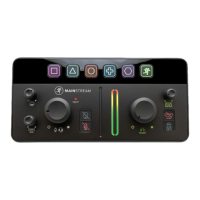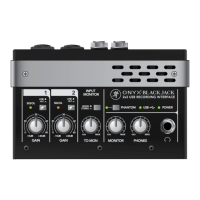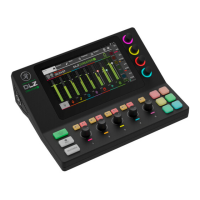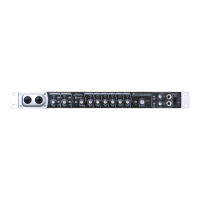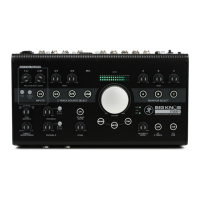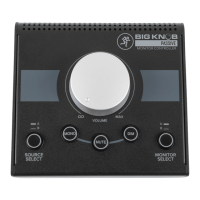Do you have a question about the Mackie HDR 24/96 and is the answer not in the manual?
Explains the manual's structure and how to use it for learning.
Describes text formatting and GUI window navigation notation.
Details conventions for front panel controls, displays, and buttons.
Details rear panel I/O, BNC, MIDI, Ethernet, and accessory slots.
Explains mouse, keyboard, and window interaction paradigms.
Describes the main GUI screen layout, time bars, and track areas.
Explains how projects and playlists track audio and edits, and the use of templates.
Details creating, opening, saving, renaming, and deleting projects.
Defines regions as audio segments and their on-screen representation and list.
Covers tools like Split, Crop, and Moving Regions for editing audio.
Explains how to format and test drives for recording and playback.
Updates lists to reflect current drive status and contents.
Explains basic transport functions like Rewind, Fast Fwd, Stop, and Play.
Covers LOC points for precise transport positioning and looping.
Explains track arming, record modes, and one-button punch.
Describes automatic punch-in/out based on preset times.
Explains All Input and Auto Input monitoring modes.
Explains soloing and muting tracks for focused listening.
Describes GUI meters, front panel LEDs, and ballistic response options.
Introduces tools like I-Beam, Hand, Magnifier for region manipulation and selection.
Covers fine adjustment of regions and cut/copy/paste operations.
Details splitting regions, cropping sections, and repositioning regions.
Describes creating fade-ins/outs and adjusting volume levels within regions.
Details the dialog for editing region attributes like name, start/end times.
Covers mouse speed, waveform colors, footswitch functions, date/time.
Explains setup for digital audio interfaces and synchronization parameters.
Describes the file structure for projects, audio, and rendered files.
Lists and describes functions found in the GUI pulldown menus.
Details how various settings are saved across projects and power cycles.
Lists parameters with factory defaults for new projects.
Explains setting up peer-to-peer networks and HDR24/96 IP addresses.
Explains the role of sample clocks, timing, and sync methods.
Guides on synchronizing using Time Code and Video signals.
Lists physical dimensions, weight, voltage, and power consumption.
Details CPU, RAM, interfaces, and hard drive specifications.
Lists supported sync formats, frame rates, and clock sources.
Explains the manual's structure and how to use it for learning.
Describes text formatting and GUI window navigation notation.
Details conventions for front panel controls, displays, and buttons.
Details rear panel I/O, BNC, MIDI, Ethernet, and accessory slots.
Explains mouse, keyboard, and window interaction paradigms.
Describes the main GUI screen layout, time bars, and track areas.
Explains how projects and playlists track audio and edits, and the use of templates.
Details creating, opening, saving, renaming, and deleting projects.
Defines regions as audio segments and their on-screen representation and list.
Covers tools like Split, Crop, and Moving Regions for editing audio.
Explains how to format and test drives for recording and playback.
Updates lists to reflect current drive status and contents.
Explains basic transport functions like Rewind, Fast Fwd, Stop, and Play.
Covers LOC points for precise transport positioning and looping.
Explains track arming, record modes, and one-button punch.
Describes automatic punch-in/out based on preset times.
Explains All Input and Auto Input monitoring modes.
Explains soloing and muting tracks for focused listening.
Describes GUI meters, front panel LEDs, and ballistic response options.
Introduces tools like I-Beam, Hand, Magnifier for region manipulation and selection.
Covers fine adjustment of regions and cut/copy/paste operations.
Details splitting regions, cropping sections, and repositioning regions.
Describes creating fade-ins/outs and adjusting volume levels within regions.
Details the dialog for editing region attributes like name, start/end times.
Covers mouse speed, waveform colors, footswitch functions, date/time.
Explains setup for digital audio interfaces and synchronization parameters.
Describes the file structure for projects, audio, and rendered files.
Lists and describes functions found in the GUI pulldown menus.
Details how various settings are saved across projects and power cycles.
Lists parameters with factory defaults for new projects.
Explains setting up peer-to-peer networks and HDR24/96 IP addresses.
Explains the role of sample clocks, timing, and sync methods.
Guides on synchronizing using Time Code and Video signals.
Lists physical dimensions, weight, voltage, and power consumption.
Details CPU, RAM, interfaces, and hard drive specifications.
Lists supported sync formats, frame rates, and clock sources.
| Audio Channels | 24 |
|---|---|
| Bit Depth | 24-bit |
| Storage Medium | Internal Hard Drive |
| Type | Hard Disk Recorder |
| Display | LCD |
| MIDI | Yes |
| Word Clock | Yes |
| External Storage | SCSI |
| Automation | Yes |
| Effects | No |
| EQ | No |
| Dynamic Processing | No |
| Sample Rate | 96kHz |
| Analog Inputs | 24 |
| Analog Outputs | 24 |
| Digital Inputs | AES/EBU |
| Digital Outputs | AES/EBU |
